Correcting the Record on the First Emoji Set
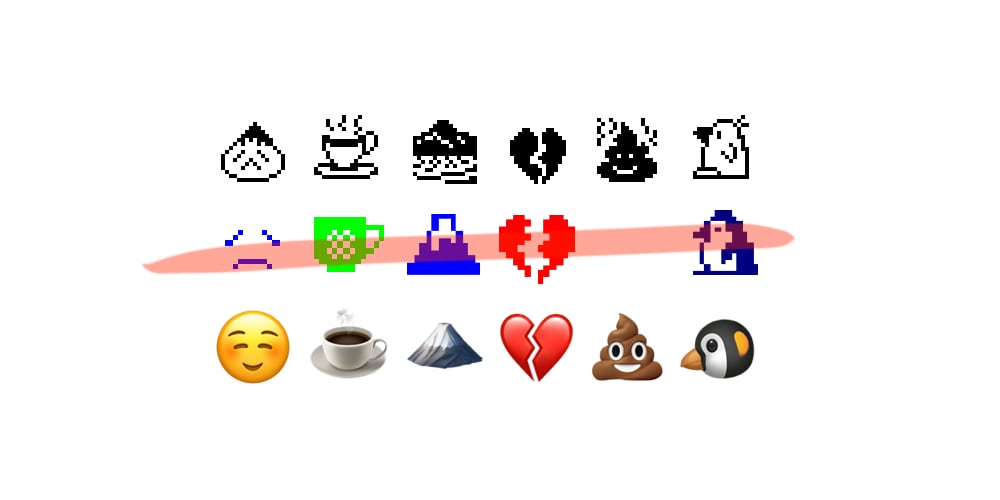
Until now, Japanese phone carrier Docomo has most often been widely credited as the originator of what we know as emoji today. It turns out, that might not be the case, and today we are correcting the record.
SoftBank, the carrier that partnered with Apple to bring the iPhone to Japan in 2008, released a phone with support for 90 distinct emoji characters in 1997. For the first time, these are now available on Emojipedia.
The 90 emojis from SoftBank in 1997 predate the set of 176 emojis released by Docomo in 1999, which until now have most commonly been cited (including by Emojipedia) as being the first.

Not only was the 1997 SoftBank emoji set released earlier than the first known date of the Docomo emoji set (in "1998 or 1999"), one of the most iconic emoji characters now encoded as 💩 U+1F4A9 PILE OF POO in the Unicode Standard, originated in this release.
Unless or until we find evidence that Docomo had an emoji set available prior to this release, we hereby issue a correction that the original emoji set is from SoftBank in Japan in 1997, with designer/s unknown.

Emojipedia Archives
Emojipedia was founded in 2013 and originally listed only current-day Apple emoji designs. In recent years, we have been making efforts to ensure 'the missing years' of emoji releases from the late 1990s until 2013 - arguably some of the most important historically - are preserved in our archives.
📜 Delve into our emoji archive you never know the treasures you might find 👼 https://t.co/pmo9t32y8O pic.twitter.com/agy5058d5d
— Emojipedia 📙 (@Emojipedia) April 6, 2018
Last year we finished documenting emojis which originate in early versions of Windows, Android, and iPhone OS (as it was known when emoji support first came to iOS).
Apple's emoji set turned 10 in 2018 and this was an opportune time to look back at how much had changed, and yet how familiar many designs remained.
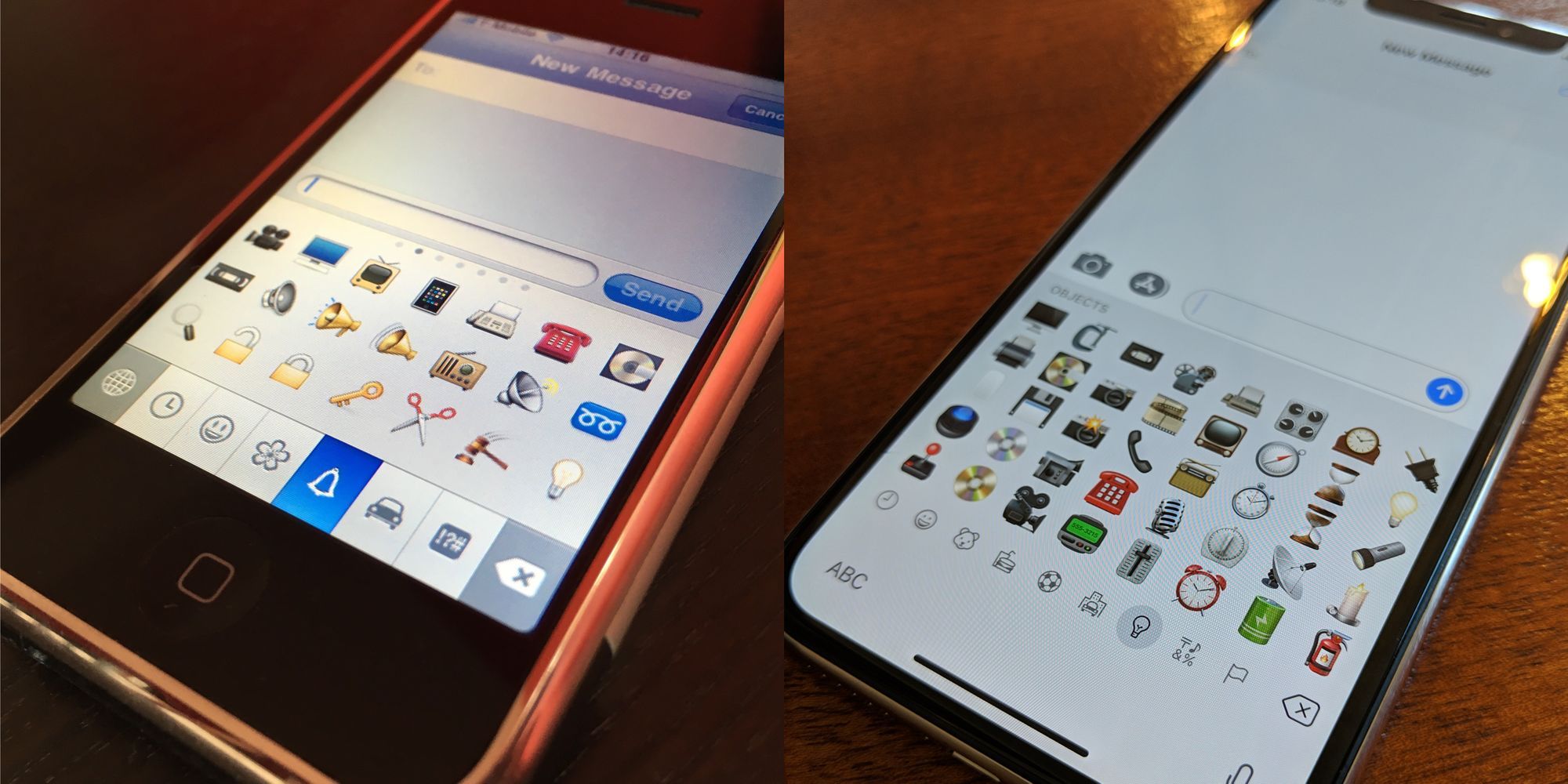
In the process of updating the Emojipedia archive to include Japanese emoji sets, it quickly became clear that there were gaps.
The Unicode Consortium has long listed one version of Japan's emoji sets from each of the three major Japanese carriers - but being a standards body and not an emoji archive, it wasn't clear how many versions of each emoji set existed in Japan over these years.
After speaking with others in this space, it quickly became clear that there were a large number of revisions to Japanese emoji sets that we hadn't even begun to document.
If these emoji designs look *familiar* to iOS users, it’s because they are the set from SoftBank - the carrier Apple first partnered with to bring the iPhone to Japan 📱 🇯🇵 pic.twitter.com/uB2UoYKAXn
— Jeremy Burge 🐥🧿 (@jeremyburge) February 20, 2018
While work to list other Japanese emoji sets on Emojipedia is ongoing, this article serves as a note regarding what appears to be solid evidence that SoftBank had the first emoji set.
Here is the 1997 Softbank emoji set mapped to its modern Unicode code points on Emojipedia:
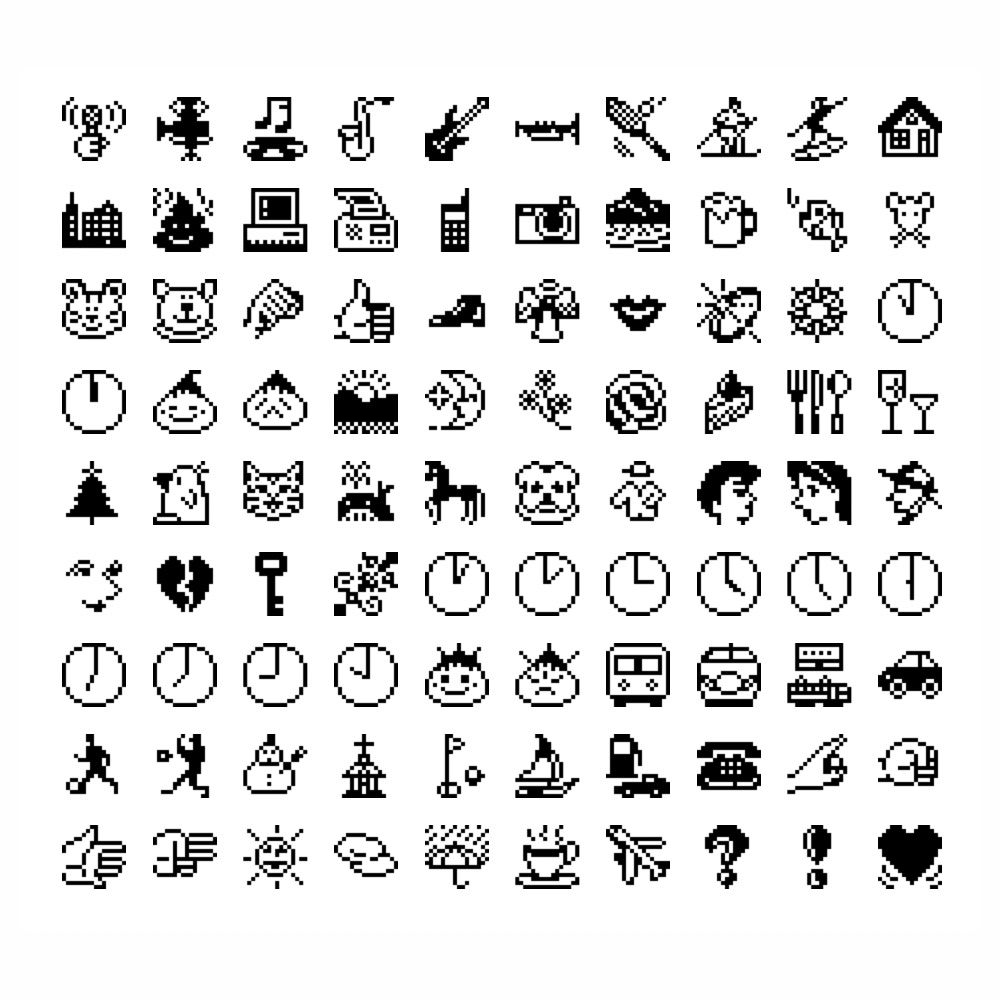
How did we get it so wrong?
How can an entire internet get a fact like “who created emoji” so wrong? A few ways.
Partly the issue relates to the time. The 1990s internet wasn't as hyper-focussed on software details, and mobile phones tended to run a weird assortment of mostly-terrible operating systems. Documenting changes would have been costly, and potentially of little interest when each model of phone might have a very different interface to the last.
In fact, when Emojipedia launched in 2013, public interest in emoji updates remained minimal. It was only by 2014 and 2015 where public interest and awareness in emoji and how it relates to major tech companies increased.

When it comes to early Japanese emoji sets, there's also a language barrier, particularly for English-language websites covering what may have already been documented in Japan.
Lastly, there's the issue of simplicity and narrative. People love a simple answer to a complex question, and pointing to one person – Shigetaka Kurita — who “created emoji” is simpler than referencing an evolution of obscure phone models with uncredited designers and engineers.

None of this is to take away from the work of Kurita. Merely to correct the record, as we too, have cited this 1999 origin in the past. There's no doubt that the spread and popularity of emoji has many chapters, each with its own story to tell.
As of 2019, we will begin correcting previous Emojipedia entries to reflect the fact that SoftBank, not Docomo, had the first emoji set in Japan.
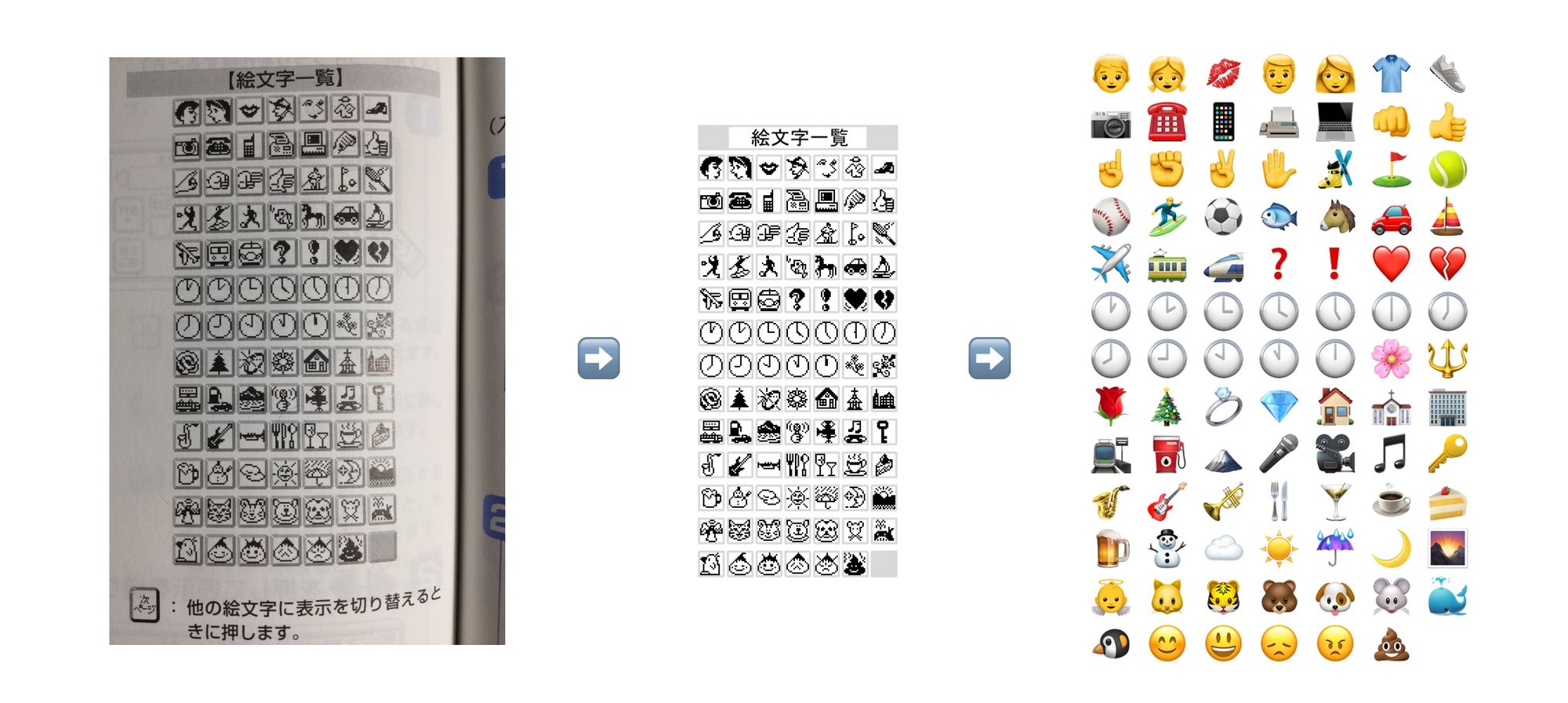
Much credit for this correction should be given to Mariko Kosaka who highlighted the fact that the "original" emoji set from Docomo likely was not the first one, back at ffconf in Brighton in 2016.
Also notable is the social media blog Socializzed, which brought up similar points and went into detail about this same issue in 2017. At the time, Porto Rebaix wrote (archived URL) about the specific emoji images that can be traced back to this emoji set:
The emoji of a spouting whale can be clearly seen in an image of the DP-211 SW distributed by Pioneer for press notes. It is just a question of time that the designers of the Skywalker Emojis and the developers behind this innovative mobile phone ahead of its time receive a well-deserved recognition.

In fact, Shigetaka Kurita himself tweeted in January 2019 that “The first emoji use in mobile devices in Japan was a pager, but in mobile phones DoCoMo wasn't the first, I think it was J-PHONE DP-211SW”:
日本のモバイル端末における絵文字はポケベルが最初ですが、ケータイに関しては私が開発したドコモの絵文字が最初ではなく、J-PHONEのパイオニアDP-211SWが最初だったと思います。#平成ネット史 #emoji
— (く)りたしげたか / Vtuberマロン (@sigekun) January 3, 2019
The First Emoji Phone
SoftBank, known as J-Phone at the time, released the SkyWalker DP-211SW with 90 distinct emoji characters in November 1997.
Not only does the photo attached to the press release show the aforementioned spouting whale emoji, a manual produced for a related model clearly shows the emoji picker with a choice of these 90 emojis:
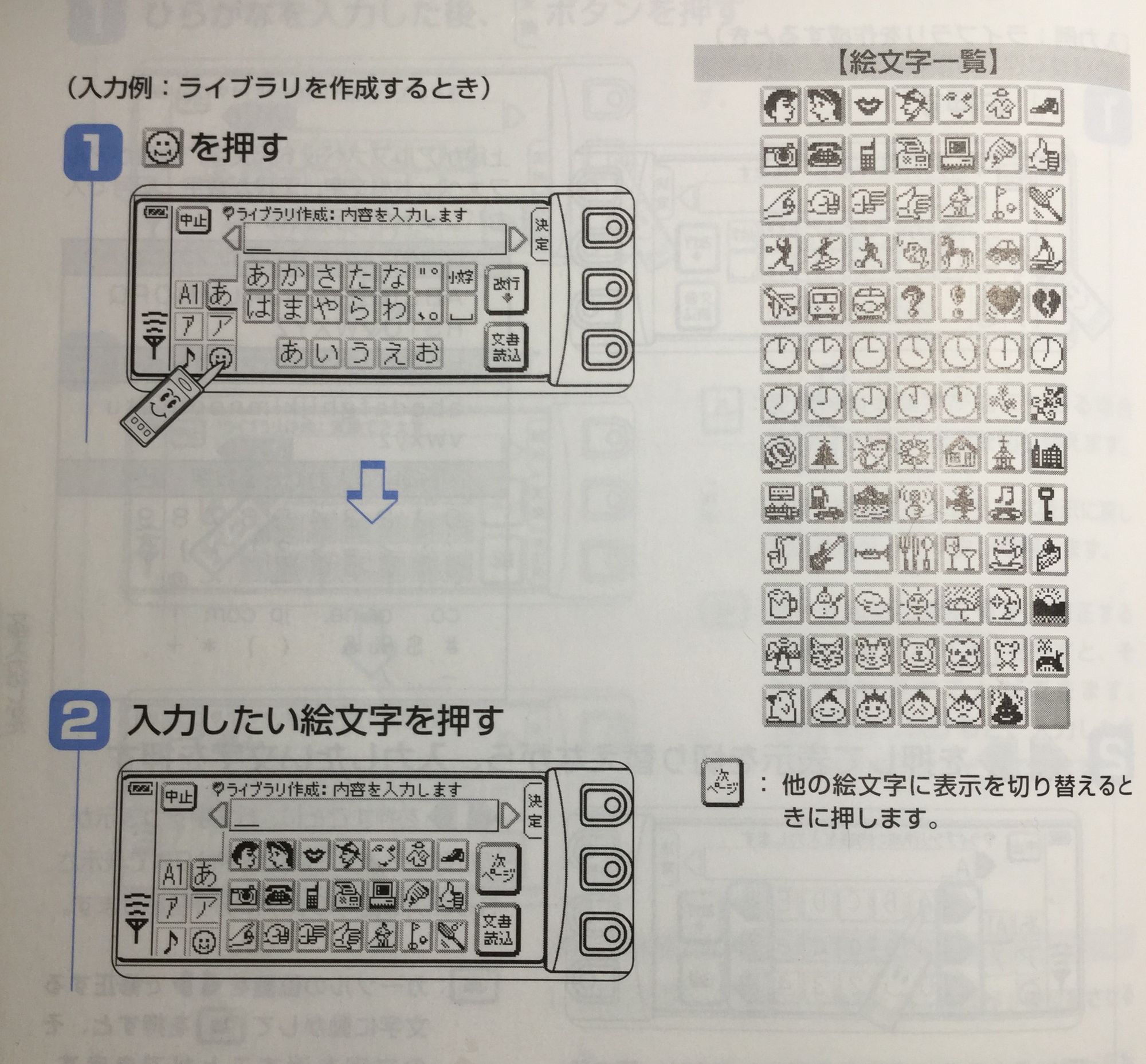
Thanks to the press release for the phone, we have a specific date that the first emoji set came to mobile phones: November 1, 1997.
The drawback to this story? The DP-211SW didn't sell well, and the emojis weren't supported on any other J-Phone device. So unless you knew people with this exact phone, emoji was borderline pointless to you.
Both the SoftBank and Docomo emoji sets look very different, and may well have been in development at similar times. As noted by Jeff Blagdon in the seminal emoji origin article from 2013 “How Emoji Conquered the World”, Docomo had a single heart available on its pagers as early as 1995:
‘In 1995, sales of pagers were booming among Japan’s teenagers, and NTT Docomo’s decision to add the heart symbol to its Pocket Bell devices let high school kids across the country inject a new level of sentiment (and cuteness) into the millions of messages’
Perhaps the heart emoji alone could be considered the first emoji; though as with all technological advancements, sometimes it's a challenge to determine exactly what constitutes the first of anything.
Blagdon has great first-hand details from Kurita and his inspiration for the set: AT&T's Pocket Net service:
‘At the time, the specs on the devices were really poor, so they weren’t able to display images, for example,” Kurita explains. Pocket Net had weather news, but things like ‘cloudy’ and ‘sunny’ were just spelled out in text. The lack of visual cues made the service more difficult to use than it ought to be, and Kurita recognized that AT&T’s mobile experience would benefit majorly from some extra characters to show contextual information.’
In Docomo's favor? The devices that shipped with emoji support were more plentiful, and more popular than the SkyWalker DP-211SW. Also, they all shipped with the same set of images. Not because they had to, but:
‘Kurita thought that the manufacturers that had rebuffed him earlier would be able to add some finishing touches [to his 12 x 12 pixel images], turning them into something more professional. “But every single one just took what we had and implemented it the way it was,” he says, laughing.’
Mariko Kosaka explained to Emojipedia that the entire i-mode implementation (effectively an 'early internet' for mobile phones in Japan) on Docomo included emoji support right from the start which gave it a much wider reach at the time than competing platforms.
Looking back now, it's quite likely that while the SoftBank emoji set came ahead of Docomo, the common use of emoji may be more thanks to the work of Kurita and i-mode.
From Japan to Unicode
Emoji sets in Japan were not standardized in any meaningful way, though some carriers did aim to provide the same emojis as other platforms.
- Apple's emoji set was derived from SoftBank (which may have been the first platform with the 💩)
- Google's emoji set was derived from au/KDDI (which also had a 💩, possibly for compatibility with SoftBank)
- Docomo: no direct lineage to modern emoji sets, though certainly influential at the time of release
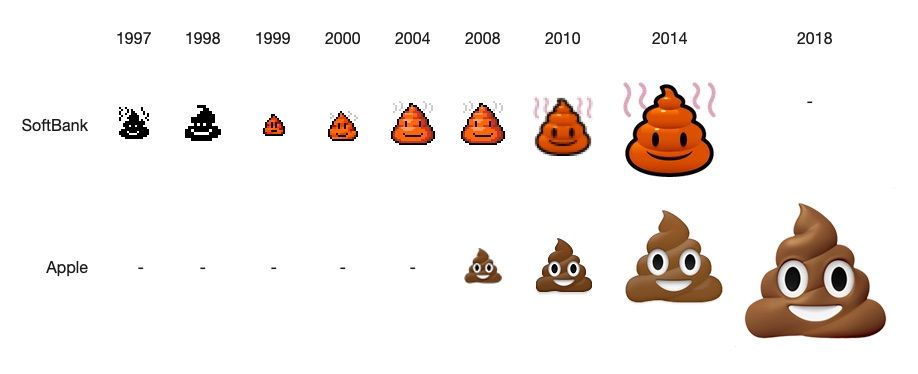
As Lauren Schwartzberg described in 2014, the work to standardize the emoji sets of Japan (and bring them to the rest of the world) was initiated by Google in their attempts to bring Gmail to Japan.
“Users could only text emoji to each other or send them through a specific email platform that only worked on mobile phones. And the telecom carriers hadn’t coordinated their code points, which left Japanese users on the constant brink of a social meltdown: sending a thumbs-up, say, could result in a thumbs-down on a different carrier’s phone. And so it went with minimal improvement until 2007, when Google partnered with one of the telecom carriers, KDDI AU, and decided to adopt emoji for Gmail. To make things simple, it volunteered to fix the code point confusion for all three Japanese telecom companies once and for all.”
What about Wingdings or Webdings?
What makes an emoji an emoji anyway?
In appearance, early emojis aren't much different to the Wingdings, Webdings or Zapf Dingbats fonts of the 1990s.
The key difference with emoji characters was that they didn't require a separate font, and instead used 'spare' code points on what were primitive mobile devices of the day. Oh, and you could input them as easily as other text characters.
You know how you used to receive the letter "J" instead of a smiley face in emails from Outlook users? That's the difference between emoji and Wingdings: emoji can be sent in plain text amongst other writing, and still appear intact, while Wingdings relied on sending a letter of the alphabet and using a font to switch how it displays.
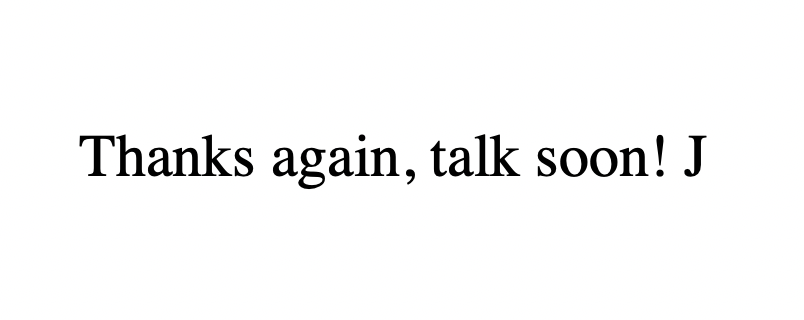
It might seem an obscure difference (even moreso now that most Webdings characters have unique code points within Unicode - see 🕴️ Man in Suit Levitating and the article from Joe Veix on its origin), but this is a key detail that allowed the spread of emoji on mobile in a way that mapping letters to pictures using fonts could never do.
The other fundamental difference is culture. So many of the emoji characters we use today directly originate from those in Japan, and while there are parallels with some Webdings characters, the origin of the modern emoji keyboard unmistakably lies with Japanese phone carriers.
Why are there so many trains on the modern emoji keyboard? Japan. 💩 Pile of Poo? Japan. 🍡 Dango? Japan. 🏩 Love Hotel? You get the idea.
Image Recovery
This set of emoji images now archived on Emojipedia didn't come out of thin air.
In addition to the aforementioned article on Socializzed in 2017, credit must go to vXBaKeRXv, an emoji enthusiast and jailbreak developer of iOS devices, who tracked down a paper manual used as the source of these images.
This manual clearly shows all emoji images, which made a pixel-for-pixel reproduction possible.
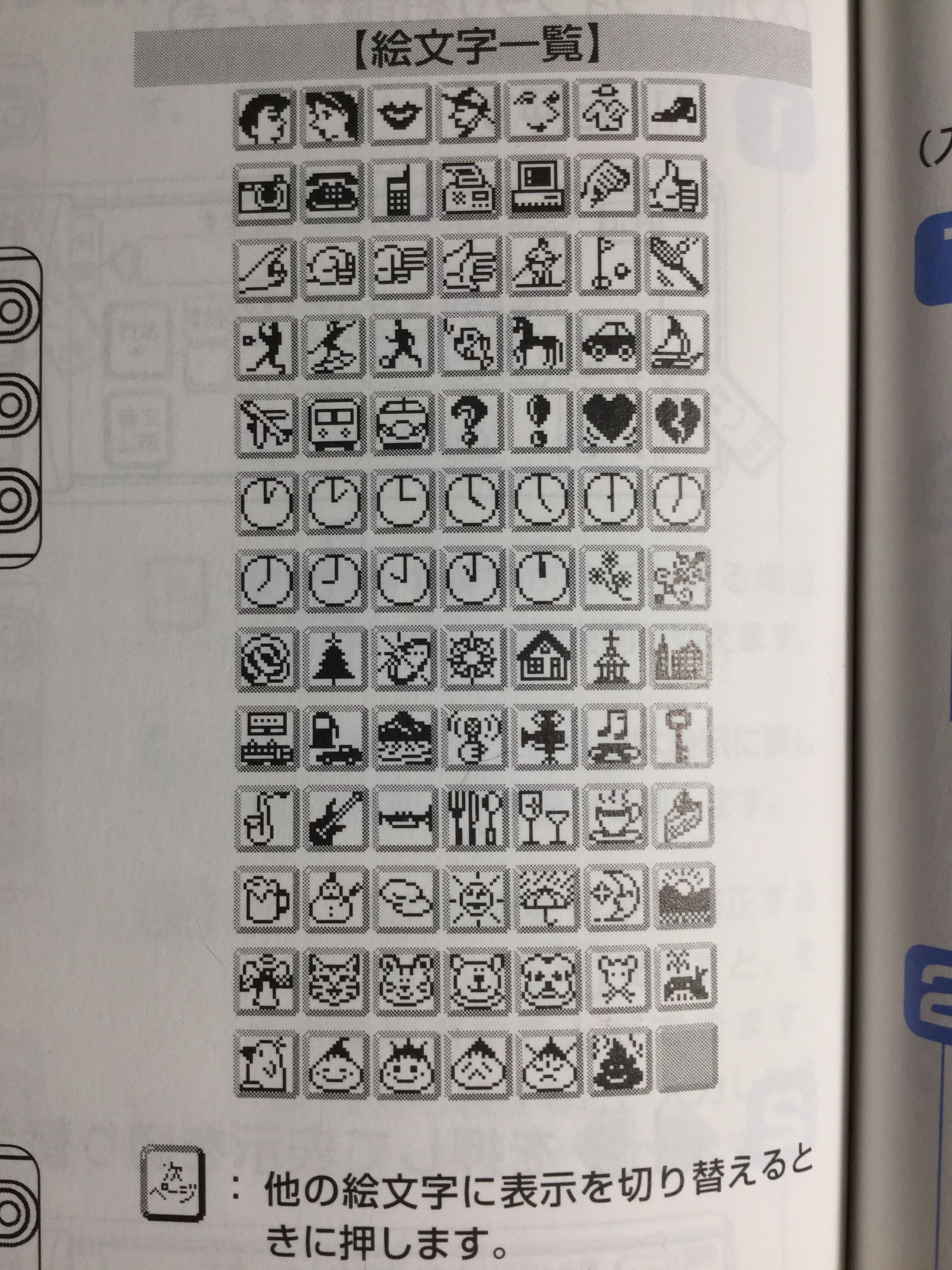
This manual was purchased by Matt Alt, author and also known for converting Japanese games for English audiences, and the pixel-art emoji images shown here were recreated by vXBaKeRXv for archival on Emojipedia. Matt Alt also has a book covering many aspects of emoji origins in Japan.
While our previous statements indicated that SoftBank's 1999 emoji set was the first from the company (with 263 animated emoji images), this set of 90 is a clear predecessor and having these images preserved for future generations is to the credit of all involved.
What now?
Is it possible that there is an even earlier undocumented emoji set from Docomo? Perhaps. Some of those first hearts from the pagers are likely worth a listing.
You might notice some weasel words in this article about SoftBank having the first emoji set, but we don't want to make the same mistake twice. While working to bring all the historical emoji sets to light, who knows what else will be discovered along the way.
For now, let's just say that this is the first emoji set that we're aware of, and we'll check back in should that change.

For more emoji history (written before this update) check out:
- Jaff Blagdon / The Verge: How Emoji Conquered the World
- Lauren Schwartzberg / Fast Company: The Oral History Of The Poop Emoji
- Jeremy Burge / Emojipedia: The Rise and Fall of Animated Emoji
- Keith Houston: Shady Characters Emoji Series
- Matt Alt / The Secret Lives of Emoji (Book): How Emoticons Conquered the World
- Jeremy Burge / Emojipedia: Emoji Creation Story
Want More? 🥇
Sign up for our free, monthly email so you're first to know the latest emoji news. Emoji Wrap is published monthly, and we won't use your email for anything else.
👇 Your email address 👇
